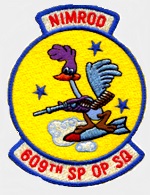Hobby Master HA3224 USAF Douglas B-26K Counter Invader Attack Aircraft - 609th Special Operations Squadron "Nimrods", 56th Special Operations Wing, Nakhom Phanom, Thailand, 1969 (1:72 Scale)
"Cave Tonitrum Latin (Beware of the Thunderbolt)"
- Motto of the 56th Special Operations Wing
 The Douglas A-26 Invader (B-26 between 1948-1965) was a United States twin-engined light attack bomber built by the Douglas Aircraft Co. during World War II that also saw service during several of the Cold War's major conflicts. A limited number of highly modified aircraft (designation A-26 restored) served in combat until 1969. The redesignation of the type from A-26 to B-26 has led to popular confusion with the Martin B-26. Although both types used the R-2800 engine, they are completely different designs. The last A-26 in active US service was assigned to the Air National Guard; that aircraft was retired from military service in 1972 by the US Air Force and the National Guard Bureau and donated to the National Air and Space Museum.
The Douglas A-26 Invader (B-26 between 1948-1965) was a United States twin-engined light attack bomber built by the Douglas Aircraft Co. during World War II that also saw service during several of the Cold War's major conflicts. A limited number of highly modified aircraft (designation A-26 restored) served in combat until 1969. The redesignation of the type from A-26 to B-26 has led to popular confusion with the Martin B-26. Although both types used the R-2800 engine, they are completely different designs. The last A-26 in active US service was assigned to the Air National Guard; that aircraft was retired from military service in 1972 by the US Air Force and the National Guard Bureau and donated to the National Air and Space Museum.
The A-26 was an unusual design for an attack bomber of the early 1940s period, as it was designed as a single-pilot aircraft (sharing this characteristic with the RAF's de Havilland Mosquito, among others). The aircraft was designed by Edward Heinemann, Robert Donovan, and Ted R. Smith. The Douglas XA-26 prototype (41-19504) first flew on July 10th, 1942, at Mines Field, El Segundo, with test pilot Benny Howard at the controls. Flight tests revealed excellent performance and handling, but there were problems with engine cooling which led to cowling changes and omission of the propeller spinners on production aircraft, plus modification of the nose landing gear after repeated collapses during testing.
In 1966, the old bomber was resurrected once more when the improved B-26K Counter Invader returned to Southeast Asia for ground-attack missions along the Ho Chi Minh Trail. Modified by On Mark Engineering, the B-26K had a rebuilt fuselage and tail, strengthened wings, improved engines, reversible propellers, wing-tip fuel tanks and other refinements. Redesignated A-26As, Counter Invaders remained in Southeast Asia until 1969 and retired from USAF service.
Pictured here is a 1:72 scale replica of a US Air Force Douglas B-26K Counter Invader attack aircraft that was attached to the 609th Special Operations Squadron, 56th Special Operations Wing, then deployed to Nakhom Phanom, Thailand, during 1969.
Sold Out!
Dimensions:
Length: 8-1/4-inches
Wingspan: 11-3/4-inches
Release Date: August 2017
 Historical Account: "Nimrods" - The 609th Special Operations Squadron is an inactive United States Air Force unit. Its last assignment was with the 56th Special Operations Wing at Nakhon Phanom Royal Thai Navy Base, Thailand. The squadron served for two and a half years combat duty during the Vietnam War, primarily flying missions over the Ho Chi Minh Trail in Laos. It earned several decorations, including the Presidential Unit Citation, before it was inactivated in December 1969.
Historical Account: "Nimrods" - The 609th Special Operations Squadron is an inactive United States Air Force unit. Its last assignment was with the 56th Special Operations Wing at Nakhon Phanom Royal Thai Navy Base, Thailand. The squadron served for two and a half years combat duty during the Vietnam War, primarily flying missions over the Ho Chi Minh Trail in Laos. It earned several decorations, including the Presidential Unit Citation, before it was inactivated in December 1969.
The 609th Special Operations Squadron was organized as the 609th Air Commando Squadron at Nakhon Phanom RTAFB, Thailand on September 15th, 1967. It was assigned to the 56th Air Commando Wing. The squadron flew the Douglas A-26 Invader, a twin engine attack bomber of WWII vintage. These aircraft were transferred from the 606th Air Commando Squadron which transitioned to other aircraft. The primary mission of the 609th was night interdiction of truck traffic along the Ho Chi Minh Trail. Its call sign for these missions was "Nimrod", inherited from the 606th and other squadrons that had flown that mission, and "The Nimrods" soon became the squadron's nickname. The squadron's A-26 aircraft carried tail letters "TA".
On August 1st, 1968, all Air Commando Wings were redesignated as Special Operations Units, and the 56th Air Commando Wing became the 56th Special Operations Wing, with the 609th Air Commando Squadron becoming the 609th Special Operations Squadron.
The night interdiction tasks of the 609th were gradually taken over by squadrons flying Lockheed AC-130 gunships, and the A-26 aircraft were phased out of active service by November 1969. By the time the last four surviving A-26s were withdrawn at the unit stand down, the squadron had flown 7,159 combat missions, and been credited with destroying 4,268 enemy supply trucks.






![USAF Boeing F-15E Strike Eagle Multi-Role Fighter - 391st Fighter Squadron "Bold Tigers", Bagram Air Base, Afghanistan, 2012 [Low-Vis Scheme] (1:72 Scale)](http://cdn4.volusion.store/qh9e9-jdqv9/v/vspfiles/photos/HA4501-1.jpg?v-cache=1740197136)


